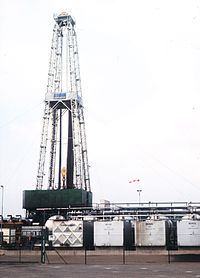Hydrocarbon exploration

Hydrocarbon exploration is a way to find and extract oil and gas from deep beneath the earth's surface.
To imagine this, think of a huge underground treasure hunt. Instead of gold and jewels, we are looking for a special type of fuel that can run engines and machines all around the world.
First, we have to choose the right spot to start our hunt. Scientists use many different clues to find the best and most hopeful places to search for oil and gas. They might use special tools to look under the earth's surface, or study rocks that have been brought up from deep within the ground.
Next, we have to make a hole deep down into the earth. This is usually done by drilling a deep well. Imagine a really long straw that can go many miles deep under the ground. This straw is called a drill bit. A big machine spins the drill bit round and round, digging deeper every time.
As the drill goes deeper, the rocks and soil it encounters are carefully examined to see if any oil or gas is present. If there is, then we might have hit the jackpot!
But, getting the oil and gas out is not as simple as just taking it out of the ground. The oil and gas are hidden in really small spots inside the rock. To get to the valuable treasure, we need to create a pathway for it to escape. This is done by using special techniques and chemicals to break apart the rock and allow the oil or gas to flow out.
Finally, the oil or gas can be collected in storage tanks and brought to the surface. From there, it can be transported to refineries where it will be processed and turned into products that we use in our daily lives.
So, hydrocarbon exploration is like a challenging treasure hunt deep underground for oil and gas that can power our world. Scientists use special clues and tools to find the best spots to drill, and then carefully extract the precious fuel hidden beneath the rocks with special techniques.
To imagine this, think of a huge underground treasure hunt. Instead of gold and jewels, we are looking for a special type of fuel that can run engines and machines all around the world.
First, we have to choose the right spot to start our hunt. Scientists use many different clues to find the best and most hopeful places to search for oil and gas. They might use special tools to look under the earth's surface, or study rocks that have been brought up from deep within the ground.
Next, we have to make a hole deep down into the earth. This is usually done by drilling a deep well. Imagine a really long straw that can go many miles deep under the ground. This straw is called a drill bit. A big machine spins the drill bit round and round, digging deeper every time.
As the drill goes deeper, the rocks and soil it encounters are carefully examined to see if any oil or gas is present. If there is, then we might have hit the jackpot!
But, getting the oil and gas out is not as simple as just taking it out of the ground. The oil and gas are hidden in really small spots inside the rock. To get to the valuable treasure, we need to create a pathway for it to escape. This is done by using special techniques and chemicals to break apart the rock and allow the oil or gas to flow out.
Finally, the oil or gas can be collected in storage tanks and brought to the surface. From there, it can be transported to refineries where it will be processed and turned into products that we use in our daily lives.
So, hydrocarbon exploration is like a challenging treasure hunt deep underground for oil and gas that can power our world. Scientists use special clues and tools to find the best spots to drill, and then carefully extract the precious fuel hidden beneath the rocks with special techniques.
Related topics others have asked about:
